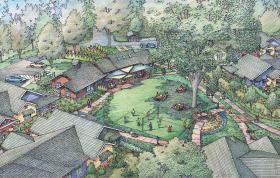A supportive cohousing community focusing on seniors who identify as LGBT broke ground last November in Durham, N.C., and is scheduled for completion in April 2020.
The Village Hearth Cohousing development will include 28 single-story accessible homes on a 15-acre wooded site, 15 minutes from downtown Durham. The homes will range in size from 650 square feet to 1,150 square feet, and they will be attached in quads for energy and construction savings. Their proximity also brings residents physically together to help build camaraderie.
The community will include a 2,600-square-foot common house with a kitchen, dining/meeting room, sitting area with a gas fireplace, laundry room, exercise studio, and art studio. There are also plans to build a separate workshop and storage building, along with a dog park, gardens, walking trails, and fire pit after residents move in. To date, 25 homes have been purchased, and the age range of owners is 55 to 73. Because several owners are relocating from out of state, the group has been hosting community-building workshops
The development fills a void in the market, as LGBT seniors often have less family support due to ostracization by family members or not having children, says co-founder Pat McAulay. “Sadly, they may feel the need to go back into the closet in mainstream retirement, assisted living, and nursing home communities,” she says. “Loneliness is an epidemic for all elders, but LGBT elders are far more likely to live alone and not have anyone they can call upon.”
Village Hearth Cohousing will also welcome gay allies among straight buyers, McAulay says. “We see the value of being ‘good neighbors’ in an environment where we can choose our own balance of privacy and community,” she says.
The planners worked with the firm of McCamant & Durrett Architects. Homes range in price from $299,000 to $409,000, and, while not designated “affordable,” the largest home will have two master suites for those who want to co-buy or home-share to pare costs. There will also be a few units available for rent.
To get to this point in development, the group has overcome several challenges. “Cohousing is a niche market, senior cohousing is even more of a niche, and adding the LGBT focus is still another niche,” McAulay says. Her group looked to Katie McCamant of CoHousing Solutions for guidance. She was among the two individuals who first introduced the cohousing model to the U.S. after seeing it in Europe. “She took us through the process step-by-step and always offered another avenue to try when we were stalled or stymied,” McAulay says.
The site was originally zoned as low-density residential, but attaching the homes and clustering them with perimeter parking (hallmarks of cohousing design) required more flexible zoning than having two homes per half-acre. The rezoning process took 13 months.
Getting a construction loan presented another challenge because the cohousing model of self-development doesn’t present itself as being as stable as developing a larger community. The group became the first cohousing community to receive financing from National Cooperative Bank.
And even the weather and landscape made the project more time-consuming. Rain plagued work, and crews ran into more rock than soil tests predicted. Yet, McAulay and her co-planners remain optimistic. “We expect to go vertical soon,” she says.
Source: magazine.realtor













